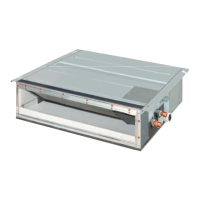Installation EDUS39-600-F2_a
22 FXDQ-M
5. INDOOR UNIT INSTALLATION
You must use the provided accessories and specified
parts designated by our company.
(1) Install the indoor unit temporarily.
• Attach the hanger bracket to the suspension bolt. Be
sure to fix it securely by using a nut and washer from
the upper and lower sides of the hanger bracket. (Refer
to Fig. 5)
[ PRECAUTION ]
Since the unit uses a plastic drain pan, prevent welding
spatter and other foreign substances from the air outlet
during installation.
(2) Adjust the height of the unit.
(3) Check if the unit is horizontally level.
CAUTION
• Make sure the unit is installed level using a level or a
plastic tube filled with water. In using a plastic tube
instead of a level, adjust the top surface of the unit to the
surface of the water at both ends of the plastic tube and
adjust the unit horizontally. Be aware that if the unit is
installed so that the slope is not in the direction of the
drain piping, this might cause leaking.
(4) Tighten the upper nut.
6. REFRIGERANT PIPING WORK
For refrigerant piping of outdoor units, see the installa-
tion manual attached to the outdoor unit.
Execute heat insulation work completely on both sides of
the gas piping and the liquid piping. Otherwise, or water
leakage can result.
Use insulation that can withstand temperatures of at least
250°F. Reinforce the insulation on the refrigerant piping
according to the installation environment.
If the temperature
above the ceiling reaches 86°F or the humidity RH80%,.
condensation may form on the surface of the insulation.
CAUTION
Follow the points at below.
• Use a pipe cutter and flare suitable for the type of refriger-
ant.
• Apply ester oil or ether oil to the flare section when using a
flare connection.
• Only use the flare nuts included with the unit. Using differ-
ent flare nuts may cause the refrigerant to leak.
• To prevent dust, moisture or other foreign matter from infil-
trating the piping, either pinch the end or cover it with tape.
• Do not allow anything other than the designated refrigerant
to get mixed into the refrigerant circuit, such as air. If any
refrigerant gas leaks while working on the unit, thoroughly
ventilate the room immediately.
• The outdoor unit is charged with refrigerant.
• Be sure to use both a spanner and torque wrench together,
as shown in the drawing, when connecting or disconnect-
ing pipes to/from the unit. (Refer to Fig. 6)
• Refer to the Table 1 for the dimensions of flare nut spaces.
• Apply ester oil or ether oil to flare section (both inside and
out) when using flare nut connections and then turn 3 or 4
times by hand. (Refer to Fig. 7)
• Refer to Table 1 for tightening torque.
Ta ble 1
CAUTION
Overtightening may damage the flare and cause leaks.
Ensure that oil does not to adhere to any portions other
Part to be procured
in the field
[ Securing the hanger bracket ] [ How to secure washers ]
Washer for
hanging bracket (8)
Hanger
bracket
Tighten
(double nut)
Fig. 5
Insert below washer
Washer fixing plate(11)
(accessory)
(accessory)
Vinyl tube
Level
Pipe size
(in.)
Tightening
torque
(ft.lbf)
Flare dimensions A
(in.)
Flare shape (in.)
φ1/4 10.4–12.7 0.342–0.358
φ3/8 24.1–29.4 0.504–0.520
φ1/2 36.5–44.5 0.638–0.654
φ5/8 45.6–55.6 0.760–0.776
Tor que wrench
Spanner
Ester oil or ether oil
Piping union
Flare nut
Fig. 6 Fig. 7
R0.016-0.031
A
90˚± 2˚
45˚±2˚

